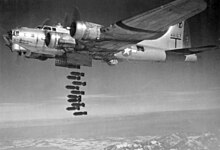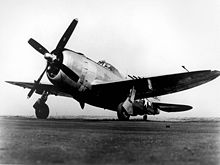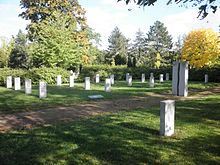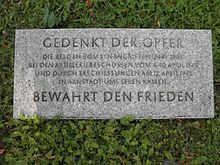Air raids on Arnstadt
The Thuringian district town of Arnstadt experienced several Allied air raids during World War II , of which the attack by the United States Army Air Forces on February 6, 1945 was the most severe. Artillery bombardment followed from April 3 to 10, 1945 , before it was occupied by US ground troops . Air strikes and artillery hit residential areas, commercial facilities, train stations and cultural buildings. A total of around 155 civilians (including many women and children), an unknown number of members of the Wehrmacht as well as foreign workers and prisoners lost their lives.
Air raid
In addition to the usual air raid shelters , there were air raid shelters for large companies, including bunkers, hospitals and military hospitals, the Reichsbahn, the air raid command post at Neutor, a tunnel construction on the Arnsberg and a bunker at the Schönbrunn spring. Hospitals (district hospital, Marienstift) and reserve hospitals ( Arnsberg school, girls' school) had large Red Cross signs on their roofs. The first hospital train arrived in Arnstadt on June 8, 1940, and many more followed. In 1943, cover ditches were created to protect against sudden air raids: for example in the Old Cemetery, on the High Wall, at the Kurhaus, on the market square, in Wachsenburg-Allee, in the suburban settlement, on the Bach loop.
Chronology of the air war events in and around Arnstadt
Events from 1940 to 1944
The air war events from 1940 to 1943 were initially only carried out by the British Royal Air Force (RAF)
The following information comes from the "Chronik Arnstadt"
- August 1940: first air raid alarm in Arnstadt.
- 12./13. August 1940: two British planes fly over the city in the evening. Aircraft alarms and detonations from the direction of Bad Berka were heard again during the night .
- 16./17. August 1940: an air raid alarm and detonations from the direction of Marlishausen at night : the estate there bombed.
- 5th / 6th September 1940: air raid alarm at night, some fire bombs on Ichtershausen
- 14./15. October 1940: alarms and bombs on Achelstädt and Ichtershausen at night
- 16./17. October 1940: alarm and a few bombs in the district at night
- 18./19. October 1940: 4 bombs hit the Polte II plant at night
- 6./7. November 1940: at night a bomb strikes near the Wollmarktplatz in Arnstadt without detonating.
- 19./20. November 1940: 8 incendiary bombs fall on Arnstadt at night without causing any damage
- December 13, 1940: at night a German Heinkel aircraft crashes into the boiler house of the blue print factory, all 4 crew members are killed.
- 11./12. June 1941: Air raid alarm again for the first time in a long time.
- September 22, 1941: first air raid at the time of day
- 26./27. January 1942: again night air raid alarms
- 27./28. August 1942: after a long break again night air raid alarms
- September 15, 1942: 500 "bombed out" women and children from Cologne arrive in Arnstadt by special train
- October 27, 1942: 650 "bombed out" women and children from Düsseldorf arrive in Arnstadt on a special train
- 1943: The Bismarck fountain on the market square is dismantled and stored.
- February 1943: from now on there is an air raid alarm almost every day, sometimes several times, day and night
- 13./14. May 1943: Airborne alarm from 0.15 am to 3.30 am: 60–80 incendiary bombs are thrown on Arnstadt. There is a fire in Erfurter Strasse, in the Weisse, the Badergasse and the Schulgasse. The mayor praised the residents who prevented a major fire through their extinguishing operations.
- May 27, 1943: at 9:00 a.m. 10 British planes fly low over the city.
- July 30, 1943: again many bomb victims from major German cities arrive in Arnstadt.
- 1944: Relocation of valuable parts of the city archives and art objects from the castle museum to Griesheim , Siegelbach and Kettmannshausen
- February 24, 1944: air raid day and night. "Air battle over Gotha and Arnstadt". 6 dead in Roda . Airplane crashes in / near Ruhla , Ettischleben and Oberhof .
- March 24, 1944: Two night plane crashes.
- May 28, 1944: Three air raids. Bombs fall in the district, 14 on miters .
- April 13, 1944: The touring exhibition “Der Luftterror” opens
- July 20, 1944: air raid in the morning during a heavy air raid on Erfurt .
- July 27, 1944: Air raid alarm in the morning, two German planes crash
- July 28, 1944: an air raid alarm in the morning, an enemy plane crashes, the pilot is captured in Kettmannshausen .
- September 11, 1944: continuous air raid alarm from 10.30 a.m. to midnight. Air raids on Gossel , Crawinkel and Ilmenau . 8 bombs fall near Rudisleben , a plane crash near Liebenstein .
- September 27, 1944: morning alarm. Plane crash on a station keeper's house: 2 dead
- November 1, 1944: In the early afternoon low- flying aircraft over Arnstadt, gunfire: one dead and four injured.
- November 9, 1944: Airborne alarm in the early evening and detonations from the direction of Ohrdruf .
- November 10, 1944: 11.30 a.m. to 12.45 p.m. and 7.30 p.m. to 9.00 p.m. Air raid on Arnstadt, affects Erfurter Strasse and the police headquarters. 4 people from Arnstadt are killed.
- November 11, 1944: 7.30 a.m. to 8.30 a.m. air raid, air raid on Erfurt
- November 14, 1944: Bomb raid on Arnstadt, 7 people are killed, including 2 children
- November 15, 1944: at noon, 29 Allied planes were observed over Arnstadt. In the early evening alarm and detonations from the direction of Gotha .
- November 30, 1944: several American low- flying aircraft attack the Saalfeld- Arnstadt passenger train (just before Roda ). One woman dies, several are injured.
- 3rd, 5th and 31st December 1944: Air raids with a total of 6 dead. The burials take place in the "Heroes' Cemetery" in Arnstadt.
The February 6, 1945 air raid


On February 6, 1945, 950 B-17 “Flying Fortress” of the 1st and 3rd Air Divisions of the 8th Air Force launched from their bases in England with almost 2000 tons of bombs to attack Central Germany, accompanied by a strong escort of hundreds of fighters . In Thuringia, 12 cities were to be attacked (main target: Gotha ), including many "secondary targets ": Eisfeld , Eisenach , Friedrichroda , Greiz , Ohrdruf , Saalfeld , Schmalkalden and Waltershausen Arnstadt is not recorded in the war diary of the 8th Air Force, but it was in Target area and was attacked by a number of B-17s of the 379th Bombardment Group during the attack on Gotha. The USAAF evaluation report (SA 3192) shows: “Two groups totaling more than 50 HE (High Explosive Bombs) exploded in the northern part (of the city), with few hits on the railway systems. These include: one hit on a railway bridge and one hit on a long hall with a shed roof. Commercial and residential buildings as well as main streets received some hits. Another 15 explosions were observed in an adjacent open field at the northern end of the railway facilities. "
The following description is based on information from the Arnstadt Chronicle, the (later) state curator Rudolf Zießler and the city archivist Karl Müller.
In Arnstadt - in clear weather - 13 (16) attacking aircraft were sighted. Given their capacity, they should have loaded around 30 tons of bombs and unloaded them via Arnstadt. They flew so low that you could see the opening of the bomb bay. At 11.00 am, the “full alarm” was triggered, after the pre-alarm people had fled towards Alteburg , and from 12.00 noon the bombs fell. A "column of smoke" was seen above the Arnsberg School as an orientation for the aircraft crews. 21 buildings with 100 apartments were completely destroyed, 215 buildings were severely to moderate and 1,500 were slightly damaged. The window panes were shattered all over Arnstadt, many roofs were covered. The power went out for days. 150 bomb strikes were counted. Particularly affected were: Baumannstrasse, the Pötschke horticultural company, the station area, the station hotel, a small part of the reception building, the station maintenance office, a Red Cross barrack, the Bahnhofstrasse, here also the "Merkur" cinema, Mozartstrasse, Moltkestrasse, Bismarckstrasse, the Roonstrasse, Ichtershäuser Strasse and Neideckstrasse. One of the totally destroyed buildings was the “Old House” of the Diakonie's Marienstift (Viktor-Lutze-Straße), which was occupied by handicapped children and the wounded and marked with the Red Cross. Bombs also hit the Old Cemetery, the funnels surrounded the standing World War II monument. Of the Gottesackerkirche (now the Ascension Church), the roof and windows in particular were destroyed. The prince's court was also affected. The Bachmann hat factory on Feldstrasse burned out. The extension of the Neideckturm (landmark of the city) with its spiral staircase was hit and had to be blown up because of the risk of collapse. The roof of the gymnasium of the Fürst-Günther-Schule was damaged. Not far from the castle theater, numerous bomb craters were created. Houses on Neideckstraße showed considerable damage. The two houses on Wollmarkt / corner of Neideckstrasse were badly damaged, houses on Fasanengarten were badly affected. The Hindenburg Bridge was partially torn away. Armaments factories such as the Polte-Werke (“Polte I”, “Polte II”), Siemens and Halske AG, Mitteldeutsche Flugzeugwerke, were not bombed.
The self-help of the population played a major role in dealing with the situation after the attack. From February 7th, the NSV also took care of those affected.
Victims: 85 people (including 14 children) were killed immediately, a total of 121 were wounded in hospitals and people found buried. On February 11, a funeral ceremony was held on the market for 73 victims who had been recovered up to then - excluding the churches. 3 coffins were set up symbolically, for a woman, a man and a child. The names of the deceased were read out by the NSDAP local group leader, the speech was given by the NSDAP district leader Mütze. The burial followed in a burial ground in the New Cemetery. The individual burials - also with pastors - continued over the next few days. Most of the people had been met in Baumannstrasse (7, 9, 11, 11a), many at the Pötschke horticultural company, two sisters and the kitchen manager at Marienstift. The senior teacher Bach died in Baumannstrasse 11; his manuscript "Chronicle of Ichtershausen", which he had just completed, was recovered from the rubble. According to the registry office's death register, the causes of death ranged from total dismemberment, to total burns, to the destruction of the spine and torn head, to the severing of both arms and legs
The city archivist Karl Müller, who witnessed the event, describes the bombing as a "terrorist attack". February 6, 1945 was also referred to as the “fateful day for Arnstadt”.
In the weeks after the attack, there were frequent air raids, low-level aircraft attacks with on-board weapons, isolated bombs and several plane crashes in the area. On February 25, 6 enemy aircraft were shot down behind Bittstädt . From March 24th there was practically constant alarm. On April 1, bombs fell on the Sodenstrasse gas works.
The artillery bombardment from April 3 to 10, 1945
This description is based on the information in the Arnstadt Chronicle and the records of the city archivist and contemporary witness Karl Müller.
- 3rd / 4th April 1945: American artillery goes into fire position, also on the Wachsenburg .
The NSDAP district leader released the very extensive food depot of the Kriegsmarine in the malt factory Rehestädter Weg and later also the textile warehouse in the theater for clearing out, as it were for looting. The retailers should also offer everything they had.
Artillery bombarded the city from 8 p.m. on April 3 until 7 a.m.
- 5th / 6th April 1945: The US troops had raised their guns on the heights between Bittstädt and Röhrensee . The shelling of Arnstadt took place between 8 p.m. and 6 a.m. As a result, fires broke out, especially in old half-timbered houses. Among other things, the following were hit: the official building at the municipal power station, many houses at the coal and wood market, in Gustloffstrasse, Fleischgasse and at Ried. The old well in front of the “Zur Sonne” inn was destroyed. The historic town hall received hits, to which the right porch above the clock (corner of the Ledermarkt) fell victim. House Ledermarkt 1 badly damaged. The Jostsche Haus at the Galerie am Markt was badly damaged and its pillars were robbed. Damage occurred in the Neue Gasse, especially at the former barefoot monastery (ev. Parish hall). "Only two human lives were to be lamented" (city archivist).
- 9/10 April 1945: Heavy fire again at night, now with machine guns and tank guns.
On the day - after defensive attempts by Hitler Youth from Arnsberg - houses in the western part of the city suffered considerable damage from tank bombardment, especially in Gothaer Strasse (25, 27, 31). After an unconditional surrender was rejected by the 22-year-old city commandant, Captain Lindner, the city was fired at again from 2 p.m. to 3 p.m. The Schützsche house at the gallery on the market burned out, also the Oswaldsche pharmacy next to it. The "Güldene Greif" was damaged. The reed suffered damage again, as did houses on Berggartenweg. The stone hood of the great tower of the Liebfrauenkirche was hit, as was the upper church / Franciscan church (roof, north wall, window). The boys' school was damaged by a hit, and a hole yawned in the front of the Fürst-Günther-Schule.
7 adults and 4 children died. The city commandant was also shot in the stomach.
American tanks entered the city from 12.30 p.m.
- April 12, 1945: Engineer Mayer was killed in a riot in the Siemens settlement with foreign workers. US soldiers summoned shot 6 (7) other residents.
The material war damage was largely eliminated over the years and decades. The large gaps in the city center that are still gaping today (partly built up by prefabricated houses) go back to the decline in the GDR era.
Burial and memorial site
A redesigned war cemetery was inaugurated above a grave field in the New Cemetery on Memorial Day in 2002 by Mayor Köllmer and District Administrator Senglaub . Next to a memorial there is a floor slab with the inscription: “REMEMBERED THE VICTIMS IN THE BOMB ATTACKS OF 1944/1945, IN THE ARTILLERY SHOT FROM 4–10. APRIL 1945, AND THROUGH SHOOTING ON APRIL 12, 1945, CAME TO ARNSTADT: KEEP THE PEACE "
literature
- Chronicle Arnstadt. 704-2004. 1300 years of Arnstadt . Edited by Klaus Reinhold. 2nd enlarged and improved edition. Volume 7 (see also "Weblinks")
- Chronicle of Arnstadt. Timeline / Lexicon . Festschrift for the 1300th anniversary of the city of Arnstadt. Ed .: Andrea Kirchschlager et al. Arnstadt 2003. In it: "Nazi dictatorship and Second World War, 1933–1945"
- Roger A. Freeman: Mighty Eighth War Diary . JANES publishing house. London, New York, Sydney 1981. ISBN 0 7106 0038 0 . P. 434 f
- Lothar Günther: Missions and Fates in the Air War over Southwest Thuringia, 1944/45 . Wehry-Verlag, Untermaßfeld 2014. ISBN 978-3-9815307-6-6 . Pp. 319-323
- Karl Müller (city archivist): From Arnstadt's difficult days, spring 1945 . In: "From the past of Arnstadt and the surrounding area". 14th issue. Thuringian History Association Arnstadt eV, Arnstadt 2005. pp. 6–34
- Rudolf Zießler : Arnstadt (Arnstadt district) . In: Fate of German Monuments in the Second World War . Edited by Götz Eckardt. Henschel-Verlag, Berlin 1978. Volume 2, p. 467
Individual evidence
- ^ Roger A. Freeman: Mighty Eighth War Diary . 1981. p. 434 f
- ^ Lothar Günther: Missions and Fates in the Air War over Southwest Thuringia 1944/1945 . Wehry-Verlag 2014. pp. 319–323
- ↑ causes of death
- ↑ Karl Müller: From Arnstadt's difficult days . “From the past of Arnstadt and the surrounding area”, issue 14. Arnstadt 2005
Web links
- Chronicle Arnstadt , Ed. Klaus Reinhold, Part 7 (Arnstadt 1940–1945), pp. 1550–1572 (PDF)


